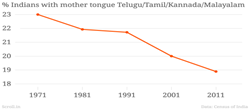

The new education policy has made Hindi the centre of a controversy. The main clause that came under fire was the "3-language formula",
Context
The new education policy has made Hindi the centre of a controversy. The main clause that came under fire was the "3-language formula", which is seen as a move to impose Hindi on non-Hindi speaking states.
Background
- Throughout the world, language is a major market of human identity – so much so that in places such as Europe, nations and language communities – such as the French, Germans and Poles – are seen as synonymous.
- While not as salient in India, here too, language has played a major part in the country’s politics.
- In India, the issue of adopting a ‘national language’ could not be resolved when the Constituent Assembly began drafting India’s Constitution.
- The adoption of a national language, the language in which the Constitution was to be written, and the language in which the proceedings of the Constituent Assembly were to be conducted were the main questions debated.
- On the one side were members from the Hindi-speaking provinces who moved a number of pro-Hindi amendments and argued for adopting Hindi as the sole national language.
Analysis
Linguistic Diversity of India
- India, undoubtably is a treasure trove of linguistic diversity, with nearly 450 living languages — 22 of them granted the status of a ‘Scheduled language’ under the Constitution.
- Nevertheless, the country also faces the perennial threat of indigenous languages dying.
- As per the first-ever linguistic survey conducted, completed between 2010 and 2013, India has already lost over 200 indigenous languages in the last 50 years.
- It is claimed that another 150 languages could vanish in the coming decades.
Language provisions in the Constitution of the Indian Union
- The Constitution adopted in 1950 stipulated that English and Hindi would be used for the Union's official business for a period of fifteen years.
- After that time, Hindi was supposed to become the sole official language of the Union.
- It proved impossible to replace English with Hindi, however, because of strong opposition from the southern states, where Dravidian languages were spoken.
- They felt that the federal government was trying to impose Hindi across the country, including the south, and preferred to continue using English, which they found more "acceptable" because, unlike Hindi, it was not associated with any particular ethnic group.
- Later, the Official Languages Act legally established Hindi and English as the languages used in Congress, while leaving states and territories free to choose their own official languages.
Does India have any national language?
- India does not have any national language.
- A national language is a language that is symbolic of a country, usually for historic, cultural and ethnic reasons.
- An official language is only designated for communication at the official level.
The spread of Hindi language
- Widespread resistance to the imposition of Hindi on non-native speakers, especially in Tamil Nadu, led to the passage of the Official Languages Act of 1963, which provided for the continued use of English for all official purposes.
- Hindi became the sole working language of the Union government by 1965 with the State governments free to function in the language of their choice.
- Meanwhile, the constitutional directive for the Union government to encourage the spread of Hindi was retained within Central government entities in non-Hindi-speaking States.
- Hindi speakers from the IT, construction and other sectors began moving for jobs to the south where many languages and dialects are spoken.
- Despite this migration to States that speak other languages, the Census found that while Hindi is the fastest growing language, the number of speakers of other languages has dropped.
- In Tamil Nadu, for example, over a 10-year period, the number of Tamil speakers of Hindi doubled largely because Tamilians needed to converse with those who came from the north.
|
Important facts on Hindi
|
History of anti-Hindi movement
- The conflict of deciding on Hindi as the official language can be traced back to the pre-Independence days.
- In 1937, the Congress-led government in Madras Presidency under the leadership of Rajagopalachari introduced compulsory Hindi education in schools across the region. (Madras Presidency was later split into four states of South India — Tamil Nadu, Andhra Pradesh, Karnataka and Kerala).
- This sparked massive protests and anti-Hindi demonstrations, especially by EVR Periyar, a pioneer of rationalist and anti-caste Dravidian politics in the region.
- The agitations lasted for three years, until the move was repealed in 1940.
- After long debates, the Parliament passed ‘Official Language Resolution’ in 1968.
- Hindi-speaking states had to teach some Indian language besides Hindi and in non-Hindi speaking states, Hindi was to be taught besides English and the local or regional language.
- This three-language formula was accepted by the entire country, but Tamil Nadu remained adamant.
Proportion of South Indian language speakers falling

- While high population growth in North India has helped Hindi surge, lower population growth in the five Dravidian language-speaking states – Tamil Nadu, Karnataka, Kerala, Andhra Pradesh and Telangana – has resulted in the proportion of Telugu, Tamil, Kannada and Malayalam falling.
- While Hindi grew by 161% between 1971 and 2011, for example, the four largest Dravidian languages grew at half that rate – 81% – over the same period.
- In addition, growing migration from north to south has meant a greater presence of Hindi in the five southern states.
How India is losing its language?
- According to the 2001 Census, India has 30 languages that are spoken by more than a million people each.
- The Constitution lists 22 languages and protects them in the eighth schedule.
- Many languages are kept out of this schedule even if they deserve to be included.
- This includes Tulu which is spoken by over 1.8 million people and has inscriptions dating back to the 14th and 15th centuries.
- When a refined language loses its status in literary and daily interactions, the way of life associated with it also vanishes.
- On the other hand, Hindi, a much younger Indo-Aryan language, has been gaining prominence since before independence. Old Hindi assimilated words from Persian.
- With the arrival of Islamic administrative rule in north India, it became Hindustani.
- The growing importance of Hindustani in colonial India and the association of Urdu with Muslims prompted Hindus in north India to develop a Sanskritised version, leading to the formation of a modern standard Hindi a century later.
- It was based on the vernacular of Delhi and the surrounding region and came to replace prestige dialects such as Awadhi, Maithili and Braj.
- The literary value of these dialects diminished in due course.
When does a language become extinct?
- According to the criteria adopted by UNESCO, a language becomes extinct, when nobody speaks or remembers the language.
- UNESCO has categorized languages on basis of endangerment as:
- Vulnerable
- definitely endangered
- severely endangered
- critically endangered
- Some critically endangered languages as per UNESCO are:
- Aimol, spoken in Manipur
- Bagahti spoken in Himachal Pradesh
- Nihali spoken in Maharashtra
- Toto in West Bengal
- Todo in Tamil Nadu
Government schemes to protect the language
Protection and Preservation of Endangered Languages of India
- Under the scheme “Protection and Preservation of Endangered Languages of India”, the Central Institute of Indian Languages (CIIL) is working on the protection, preservation and documentation of endangered languages.
- It is the onus of the CIIL to protect, preserve and document endangered languages, even language spoken by less than 1000 people also as against the scheme, which is preserving the languages, spoken by less than 10000 people.
Closing thoughts
National integration in a multilingual country does not require the imposition of one official language on the country, especially when the language selected for the purpose is one of its many regional languages even if it happens to be that of the largest linguistic group in the country. At the same time, the convenience, in fact the necessity, of having one or more languages as the official (not national, as all languages spoken in a country can claim to be national) language or languages for centre-state and inter-state communication for political, economic, legal and even social reasons cannot be disputed.


